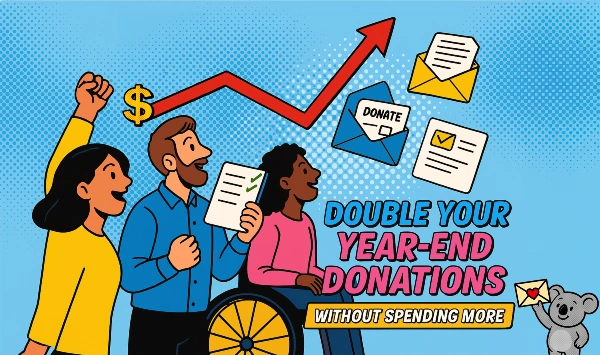Lisa Sargent’s last post on this blog, 6 Winning Ways to Start Your Next Fundraising Appeal, was so popular, that we asked her to give you even more! Over to Lisa…
The right lead on a fundraising letter is like the pace car in a race.
For both writer and reader, it ushers you into the letter “at pace”: you’re off and cruising along nicely, and quickly, without skipping a beat.
It can also be one of the hardest parts of a letter to write.
That’s why I’m sharing some approaches that work for me.
Please feel free swipe these letter openings – but not word for word – your story is unique. But just as before, every lead you’ll see has been field-tested: they work.
# 1: Summon the senses
One of the things that makes a lead powerful is when it’s unexpected. And one way to make a lead unexpected is to focus on a sensory aspect and plop it right into those opening words and lines to frame your story.
That’s what I did with this fundraising lead for an air ambulance appeal letter by zeroing in on the sound a ventilator makes as it breathes for a little boy who can’t currently breathe on his own:
Thump, whoosh… thump, whoosh… thump, whoosh…
The lifesaving rhythm of a hospital ventilator is the last thing you expect to hear on an airplane cruising at three thousand meters in the sky.
And the limp body of a boy – his little chest rising and falling with the breathing machine that keeps him alive – is the last thing you expect to see…
Maybe sound, for your story, isn’t the standout sense.
Maybe it’s the frigid cold, or the scorching heat, or a soaking rain that chills to the bone. Maybe it’s touch, as in the velvety patch of fur behind a little stray dog’s ears, the one spot on him that didn’t show signs of the sad life he’d lived to that point.
Even better?
Research has shown that sensory language engages readers on a deeper level because it lights up the regions of the brain that process those senses in real life. And I don’t know about you, but that sounds like a beautiful bonus to me.
# 2: Introduce a flawed hero
Make your stories read like epics – and introducing a flawed, ordinary hero in your fundraising lead is one of the best ways to do this. As generous, caring humans, your donors can relate to those who are broken… who’ve made mistakes, sometimes terrible ones… because in a thousand different ways, we’ve ALL stood in those same shoes.
Instantly, the main subject of your story is someone your reader can identify with – empathize with – root for. Here’s how I framed one fundraising lead by introducing a flawed hero called Martin:
The leaves crackled beneath Martin’s feet.
How many seasons had he seen on the streets?
But… no.
Martin pushed down all hope of a different life. Pushed it down beside the broken little boy from his childhood – the hurt he could never quite move on from. What that little lad had seen was too much for him to let go of.
See?
In just 61 words, you know a LOT about Martin. This letter itself was so successful as an autumn appeal the first time it mailed, that a few years later we mailed it again, to equally impressive results.
Empathy, solidarity, understanding, for one human from another, the Flawed Hero Lead Frame can do it all for you.
#3: Anchor with repetition
In part of 1 of this series on fundraising leads, I introduced the Harness the power of imagination lead frame, by showing how you can use “Imagine…” to start your letter and put the reader right into the story with one word.
What I didn’t tell you then was that the example I used is also an example of another lead frame I call anchor with repetition. Because not only does the appeal start with “Imagine,” it repeats that word – along with the phrase “You are only a child,” – for emphasis and to draw the reader in. (Pro tip? You can also repeat formatting – sparingly – when you repeat, such as underlining or italics.)
That’s really all you need to know for this lead frame; the judicious use of repetition is its magic ingredient. Like this:
Dear <<Name>>,
Imagine your belly is so empty from hunger, the pain makes you weep…
You are only a child.
But you know tomorrow will be no better. Two years of drought mean there is never enough food to eat now. One meagre meal in a day is a feast.
Imagine your skin and lungs burn like fire from the moment you wake…
You are only a child.
But today you will suffer skin made raw by toxic water, and a ragged cough from logging companies that pollute the air and lay waste to the forests and rivers of your village for easy profits.
Repetition, in the brain, brings emphasis and deepens memorability, both of which you want in a fundraising letter. Repetition also creates a pattern, which the brain loves, and creates an early predictability that helps with reading ease.
#4: Open a time machine
One of the best things about fundraising copywriting is its ability to transport your reader through time, forward and back, as it supports and enhances your story. And one of the best places to do that is in the opener to your letter.
Here’s how I did it for the extraordinary ChildVision, a nonprofit that helps children and young people with severe sight loss and other disabilities to live their absolute best lives:
Dear <<salutation>>,
They call her the Learning Girl.
And it is a far cry from the ‘grave outlook of quadriplegia’ that Mary had once been given – before she and her parents came here, to ChildVision:
There was a little blonde girl out in the playground – we saw a vision of Mary in the future. Running and playing. Tears of joy streamed down our faces as we realised that this could be our little girl. I don’t know where we’d be without ChildVision.
By moving the story from the present back through time, we are able to very quickly create a safe space through which the reader can follow a story that includes a diagnosis of “grave outlook of quadriplegia.” We didn’t solve the problem, mind you. You still need tension in a fundraising appeal.
But by opening a time machine with our lead frame, we gave the reader a way to fully feel the rest of the story without total emotional overwhelm – and by moving your lead through time, you can too.
#5: Show shared values
Connect your reader to their own deeply cherished values or personal traits. You can do this by showing them your signer or the subject of your story shares those same values. You travel light years closer to their heart in record time.
That’s why the shared values lead frame can be so effective at forging a bond with your reader, as these next two leads are about to show you:
Dear <<Name>>,
My entire life, I wanted to be part of something bigger than myself.
To connect with a cause that would leave humankind better, for my having lived.
Maybe you feel that way too.
This lead served a second purpose: it came from the head of a hospital foundation, who went on to tell the remarkable story of the hospital itself, and of the hardworking healthcare professionals who stood on call night and day to be there for the community. Because of the shared values lead frame, he was free to tell that story in a one-to-one, human voice that came from a place of strength and trust and love.
There are lots of other ways to invoke the shared values lead frame. We once told the true story (and your stories must be true), of two men who were homeless, who in a stretch of bitterly cold weather, literally carried another man into the shelter run by my client. Another told of animal rescue staff driving a veterinary ambulance through a war zone to rescue dogs and cats trapped there.
Shared values, whether it’s upholding a promise to help lost animals or a deep love for community and humankind, or the core belief of giving back for whatever we’ve been given, can be a powerful foundation for your letter.
There are lots more out there, of course – and in your work to share the stories that bring your beneficiaries, your team, and your work to life, I have no doubt that you’ll craft a lifetime of winning openers of your own and keep clear of the Land of Bad Leads forever.Looking for specific, practical advice and insight for YOUR fundraising – and connection with other fundraisers like yourself? Join our free Facebook community, the Smart Fundraisers Forum
For Lisa’s Author description (there’s nothing in it right now)
Award-winning fundraising copywriter Lisa Sargent is on a mission to transform the way nonprofits tell their fundraising stories. Founder of SOFII’s free Donation Thank-You Letter Clinics and a contributing author to Change For Better, Sargent has helped top nonprofits from Trócaire to Best Friends Animal Society to get far better results, inspire and keep more donors, and build a better world.
Related Blog Posts:
26 Tips for More Effective Fundraising Writing
Want More Fundraising Revenue? Give Donors a Personalised Experience!
3 Habits of Highly Effective Fundraising Writers












1 Comment. Leave new
Lisa,
Thank you for another amazing post!
You are an incredible copy writer and your insights are always amazing. As someone who has had the privilege this past year of taking the Institute for Sustainable Philanthropy’s Copy Writing Certificate Program – I was in awe reading your insights there, and this blog post certainly reinforces the tremendous learnings from the course.
What I particularly love is your ability to awaken the senses to make me the reader connect quickly to the copy. That opening sentence alone is so critical given the limited attention spans we must contend with in today’s world. You draw me in and make me curious about what is next – and throughout your writing you appeal to my sense of psychological well-being.
Thank you for being so generous in sharing such invaluable insights with all of us!